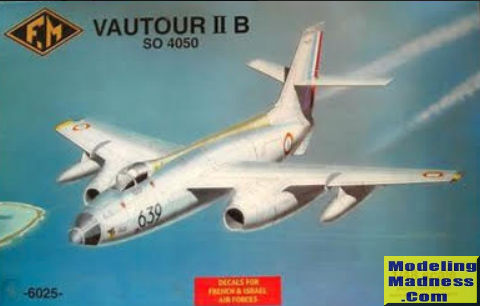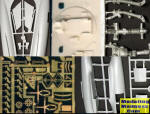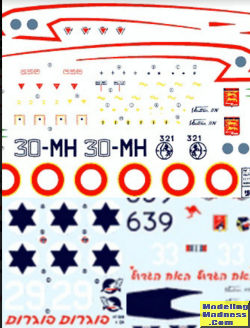
| KIT #: | 6025 |
| PRICE: | $60.00 when new |
| DECALS: | Two options |
| REVIEWER: | Spiros Pendedekas |
| NOTES: | Short run mulitmedia kit |

| HISTORY |
The S.O. 4050 Vautour II (Vulture) was a French jet-powered bomber, interceptor and attack aircraft developed and manufactured by aircraft company Sud Aviation.
The type was operated by Armée de l'Air, having been originally developed by Sud Aviation in response to a French requirement for a jet aircraft for bombing, low-level attack and all-weather interception operations. It was used in the Force de frappe under the Commandement des Forces Aériennes Stratégiques, with each aircraft being suitable for the carriage of a nuclear weapon. Its shortcomings as a bomber, such as its lack of radar or other advanced navigation/attack systems, led to the type being replaced by the more capable Dassault Mirage IV. It never saw combat use with the French Air Force.
The only other customer for the Vautour was Israel. During its service with the IAF, the type undertook various missions and roles and was quickly used during the wars between Israel and its neighbors, including the Six-Day War and the War of Attrition. Only one air-to-air kill was recorded by a Vautour; whereas the type was used more for bombing and ground strafing and was reportedly considered by Israel to be comparable to the Soviet-built Ilyushin Il-28 medium bombers used by its regional adversaries. During the early 1970s, the Vautour was replaced by the American Douglas A-4 Skyhawk.
In total, 149 units were built, including the three prototypes and six pre-production machines
| THE KIT |
 Fonderie
Miniature came in 2001 with their quarter scale vautour IIN and IIA,
followed by the bomber version (IIB) in 2005, all of them being one-off
releases, never reissued ever since (and I suppose this mainly has to do
with mold usage, which is limited in this type of short run kits). The
specific kit is the 2005 IIB bomber version, bought in 2006 from the
beautiful Maurice Verdeu Modelisme hobby shop in Bordeaux France at the
“normal” price for such category of kits of around $60
Fonderie
Miniature came in 2001 with their quarter scale vautour IIN and IIA,
followed by the bomber version (IIB) in 2005, all of them being one-off
releases, never reissued ever since (and I suppose this mainly has to do
with mold usage, which is limited in this type of short run kits). The
specific kit is the 2005 IIB bomber version, bought in 2006 from the
beautiful Maurice Verdeu Modelisme hobby shop in Bordeaux France at the
“normal” price for such category of kits of around $60
The kit comes in a neat top opening box, with a nice box art of an Armée de
l’ air Vautour, flying over the French coast. Upon opening the box, I was
greeted with the familiar sight of a (very) short run multimedia kit:
styrene “main” parts, resin “detailing” parts, white metal parts (mainly,
but not restrictively for the landing gear), a beautiful PE fret and vac
formed canopies.
There are three light gray styrene sprues, mainly catering for the bigger,
“structural” parts (fuselage, aerodynamic surfaces, engine pods, drop tanks,
but also the gear doors and speed brakes). The styrene itself is soft and
workable, with well defined panel lines, but presents a lot of flash and a
pebbly surface, meaning a good cleaning and polishing session will
definitely be ahead of you, particularly if you dare to go for the Natural
Metal Finish scheme. General shapes of parts look spot-on (meaning the kit
designer spent many hours near the actual plane), but be aware that fit is
very challenging and a lot of elbow grease will be needed during
construction.
Resin is extensively used to represent the more “detailed” sections,
including a full pilot’s cockpit tub, seat main body, instrument panel,
bombardier’s rear bulkhead which contains the upper part of his seat, the
four wheel bays, the wheels themselves, the engine compressor faces and
exhausts and some other smaller stuff. All parts are impressively molded (no
bubbles at all!) using high quality cream colored resin, but with the
standard (and not that favorable) F-M practice to pack all resin bits in one
bag, luckily taking little toll in my case (only a fraction of one of the
exhaust nozzles was broken, easily glued on with cyanoacrylate).
White metal is used to represent mainly the landing gear, but also some
other stuff (control stick, some consoles and so on) with the provided parts
looking relatively detailed, but not particularly well molded, needing some
straightening and cleanup. A superb PE fret is included, made by Eduard,
being a real enhancer of final model looks, catering for areas such as the
interior, the wheel rims, the door hinges and the like.
Options include open or closed bombardier's door, ditto speed brakes and
attachment of drop tanks or not. As a note, and per the Fonderie Miniature
trend, the modeler is called to scratch-build some “simple” parts (rods,
shafts, plates, even the landing lights...) to finalize areas like the
landing gear and the bombardier’s compartment.
Transparencies are vac formed and look nice and clear, with well-defined
frames and no signs of yellowing after all these years Two of each are
provided, meaning if things do not go well you are granted a second chance.
Instructions come in the form of three densely printed A4 pages with a few
assembly drawings and construction notes provided in French and English.
Following the well known Fonderie Miniature “Mystical Experience” trend,
they require deep study, in order to get an idea of what goes where, let
alone the fact that the actual organization of the build sequence is grossly
to the builder, something more or less expected from kits of such nature.
Internal color callouts are for the most part provided, with the net always
keen to provide its services on any additional info required. While the
initial impressions for the instructions are obscure, if you do the radical
act and deeply study them, you can more or less sort yourself out with only
few things left to imagination.
 Two
camo schemes are provided, a nice aluminum doped French and an equally nice
four tone camo Israeli. Kit decals are thin and nicely printed, still
looking in excellent condition after all these years (I used the Israeli
insignia some time ago and was really pleased with their quality).
Two
camo schemes are provided, a nice aluminum doped French and an equally nice
four tone camo Israeli. Kit decals are thin and nicely printed, still
looking in excellent condition after all these years (I used the Israeli
insignia some time ago and was really pleased with their quality).
According to whatever sequence the instructions suggest, first you are
supposed to build the cockpit and bombardier’s section and trap them,
together with the two main bays, between the fuselage halves. The main wings
which contain the engine pods are then assembled and attached, followed by
the all-moving tailplanes and the wing tanks. Landing gear is next, followed
by the transparencies, ending a build of a certainly high degree of
complexity, not only due to the styrene parts fit, but also due to the
extended use of resin, PE and white metal, let alone the need for
fabrication of some "simple" parts.
| CONCLUSIONS |
November 2023
Copyright ModelingMadness.com. All rights reserved. No reproduction in part or in whole without express permission.
If you would like your product reviewed fairly and quickly, please contact the editor or see other details in the Note to Contributors.